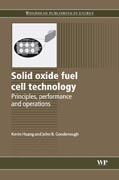
Solid oxide fuel cell technology: principles, performance and operations
Huang, K.
Goodenough, J.B.
-Provides a comprehensive review of solid oxide fuel cells from history and design to chemistry and materials development - presents analysis of operational features including current flow, energy balance, voltage losses and electrical efficiency - explores fuel cell stability and durability with specific chapters examining performance characterization, fuel processing and electrode poisoning High temperature solid oxide fuel cell (SOFC) technology is a promising power generation option that features high electrical efficiency and low emissions of environmentally polluting gases such as CO2, Nox and Sox. It is ideal for distributed stationary power generation applications where both high-efficiency electricity and high-quality heat are in strong demand. For the past few decades, SOFC technology has attracted intense worldwide R&D effort and, along with polymer electrolyte membrane fuel cell (PEMFC) technology, has undergone extensive commercialization development. This book presents a systematic and in-depth narrative of the technology from the perspective of fundamentals, providing comprehensive theoretical analysis and innovative characterization techniques for SOFC technology. The book initially deals with the basics anddevelopment of SOFC technology from cell materials to fundamental thermodynamics, electronic properties of solids and charged particle transport. This coverage is extended with a thorough analysis of such operational features as current flow and energy balance, and on to voltage losses and electrical efficiency. Furthermore, the book also covers the important issues of fuel cell stability and durability with chapters on performance characterization, fuel processing, and electrode poisoning. Finally, the book provides a comprehensive reviewfor SOFC materials and fabrication techniques. A series of useful scientific appendices rounds off the book. Solid oxide fuel cell technology is a standard reference for all those researching this important field as well as those working in the power industry. INDICE: Introduction to solid oxide fuel cells (SOFCs) A brief history of the solid oxide fuel cell (SOFC). Advantages of the solid oxide fuel cell. Applications of solid oxide fuel cell. Solid oxide fuel cell components and functionality. Solid oxide fuel cell designs. Thermodynamics of the solid oxide fuel cell (SOFC) Electromotive force (EMF) and Gibbs free energy change ( G). Effect of concentration on electromotive force (EMF). Heat effects in a galvanic cell. The temperature coefficient of electromotive force (EMF). The pressure coefficient of electromotive force (EMF). The thermal and chemical expansion coefficients. Electronic properties of solids for solid oxide fuel cells (SOFCs)General considerations. Redox 4fn energies and polaronic conduction. Ligand-field d-electron energies. Localized versus itinerant d-electrons. Applications. Transport of charged particles in a solid oxide fuel cell (SOFC) General bulk transport theory. Effect of electronic conduction in electrolyte on electromotive force (EMF). Application to electrolyte: steady-state Po2 distribution. Application to electrolyte: electronic leakage current density. Application tointerconnect: steady-state Po2 distribution. Application to interconnect: ionic leakage current density. Pressure effect on electronic leakage current density in the electrolyte. Oxide-ion electrolytes in solid oxide fuel cells (SOFCs) Quality criteria. Phenomenology. Random-walk theory. Fluorites. Perovskites. Other oxides. Current, gas flow, utilization, and energy balance in a solid oxide fuel cell (SOFC) Introduction. Fuel flow, current, and fuel utilization.Air flow, current, and oxygen utilization. Fuel consumption. Calculating stack fuel composition of reformed natural gas. Energy balance in a solid oxide fuel cell system. Voltage losses in a solid oxide fuel cell (SOFC) Ohmic polarization. Activation polarization. Concentration polarization. A combined activation and concentration polarization of the cathode. Distributions of electro motive force and current density. Effect of leakage flux on the voltage-current curve. Direct current (DC) electrical efficiency and power of a solid oxide fuel cell (SOFC) Direct current electrical efficiency. Efficiency, fuel utilization, and electrical power. The maximum direct current electrical efficiency. Effect of the system pressure on direct current electrical efficiency. Performance characterization techniques for a solid oxide fuel cells (SOFC) and its components Electrochemical impedance spectroscopy. Galvanic current interruption. Voltage-current curve characterizations. "Helium-oxygen shift". Fuel sensitivity. Determination of fuel loss. Electrical conductivity and sheet resistancemeasurements. Determination of porosity and density of a porous ceramic body.Diffusivity and diffusion conductance measurements. Steam methane reforming and carbon formation in solid oxide fuel cells (SOFCs) Introduction. Thermodynamics of the steam methane reforming. Partial pressure of oxygen (Po2) and Nernst potential (E) of the steam-reformed methane. Kinetics of the steam methane reforming. Carbon formation: thermodynamics versus kinetics. Poisoning of solid oxide fuel cell (SOFC) electrodes Sulfur poisoning of the anode. Silica poisoning of the anode. Phosphorus poisoning of the anode. Chromium poisoning of the cathode. Materials for solid oxide fuel cells (SOFCs) ZrO2-Based solid oxide fuel cells. CeO2-based solid oxide fuel cells. LaGaO3-based solid oxide fuelcells. Interconnects and cell-to-cell connectors. Fabrication techniques. Conclusions.
- ISBN: 978-1-84569-628-3
- Editorial: Woodhead
- Encuadernacion: Cartoné
- Páginas: 340
- Fecha Publicación: 01/07/2009
- Nº Volúmenes: 1
- Idioma: Inglés
